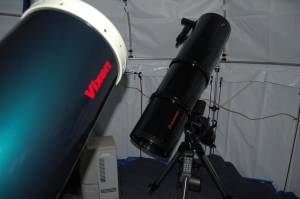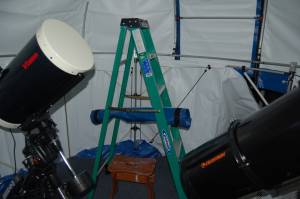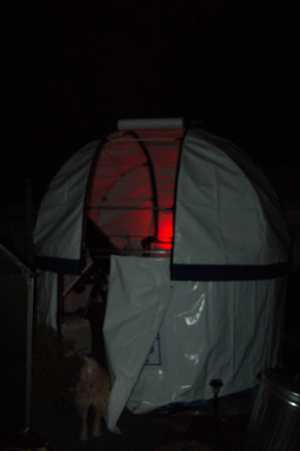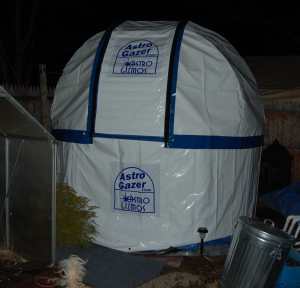BRIDGEPORT, WV - (S-M) - Here at our home base in Bridgeport, West Virginia, we recently installed an 11 foot diameter Astrogazer observatory dome made by a small company called AstroGizmos.
Using a large telescope can be a large amount of trouble if one does not have an observatory to keep the instrument in. Though we had a nice dolly to move the telescopes outside and back, we were plauged with the dew and frost which inevitably forms on any telescope which has cooled to a working temperature. Also, from our location here in West Virginia, the coldest nights of the northern Winter are generally the most clear and dark, but the chill of the wind can dampen even the most dedicated astronomer's enthusiasm. So, it was decided that we needed an observatory of some sort, and with impatience, we ordered the first observatory we could find which was in stock and ready to be put on a truck, destined for our doorstep.
A few days later, three large heavy boxes were delivered. Upon opening the cartons, the observatory was found to consist of a seemingly uncountable number of aluminum tubes, some plastic and metal fittings, and some very large and well cut pieces of synthetic canvas. It looked almost exactly like a kit for an ultralight airplane. After some initial consternation over the large number of pieces, it was found that the parts were all color coded at the joints where they fit together. On the snowy afternoon of 12 December, we launched into the construction of the observatory with the intention of keeping on until it was finished.
Sixteen hours later, on the morning of the thirteenth, the building was finished, with the exception of the telescope installation. No floor is provided with the dome, and we made one consisting of several layers of poly-tarp and some outdoor carpet, all of which was curled up around the inner edges of the building to provide a good seal against water. Some treated plywood was put down on the ground to cover two large mudholes.
We moved two ten inch telescopes into the observatory over the next few days. Setting up big telescopes is always a chore, as the mirrors are sure to become misaligned when the telescopes are moved, and the equatorial mounts require polar alignment. A string of cloudy nights also caused delay.
Still, two weeks later we have the observatory fully servicable, and we are very pleased. With no air movement, even single digit temperatures are of no concern, and it is apparent when viewing the sky from inside the dome that far dimmer stars can be seen than when out in the open, due to the blocking of all ambient light. Further, the telescopes are always cooled to near outside temperature, which greatly improves the small-scale turbulence in the light path into the telescopes, and allows much finer detail to be seen, particularly on the Moon.
As the Moon was waning in mid-December, we turned the telescopes upon it. As always, we were amazed by the details which could be seen. Near the rim of Mare Crisium, we noted a cross-shaped formation of four tiny craters which we had not seen before. Though they were obviously craters at high power, at lower powers they blended together into a perfect "X" which looked almost artificial. With the excellent conditions in the observatory, we were able to use powers of up to 750x on our 10" Japanese telescope.
The splendid open star clusters of the Winter sky have also been seen, and besides the Double Clusters in Perseus, the three famous clusters in Auriga have also put in an appearance at the observatory. M37 is a particularly fantastic cluster, and could be mistaken for a well-resolved globular object. The number of stars visible was at least several hundred, with one possible red giant near the center which outshone them all.
Later in the mornings, we have seen Saturn rising due East. The rings have closed even more since early November, and now appear almost as a line across the planet.
We can only imagine what surprises the sky might hold in store for us to see from the observatory in the future. At least one moderately bright naked-eye comet is on its way next year, and the comets Christensen and Broughton are still visible high in the north. A new comet could come along at any time, and we are still long overdue for a visible supernova in our home Galaxy. We are also looking forward to the next opposition of Mars. Whatever the sky may bring into our view, we hope to be waiting here at our observatory for a long time to come. -- GW



The
TM
Astronomy From West Virginia
DECEMBER 12, 2008 - OUR NEW STARRY MIRROR OBSERVATORY
Copyright 2008 Starry Mirror




The Observatory is fenced in to provide protection from wind and other undesirable elements.
There is enough room inside the Observatory for two large telescopes and assorted equipment.
The ladder is required to open and close the shutter on the dome.
At night, only red lights are used in the Observatory.